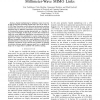Free Online Productivity Tools
i2Speak
i2Symbol
i2OCR
iTex2Img
iWeb2Print
iWeb2Shot
i2Type
iPdf2Split
iPdf2Merge
i2Bopomofo
i2Arabic
i2Style
i2Image
i2PDF
iLatex2Rtf
Sci2ools
GLOBECOM
2009
IEEE
2009
IEEE
Nonuniform Array Design for Robust Millimeter-Wave MIMO Links
—Spatial multiplexing for millimeter (mm) wave line of sight (LOS) links potentially enables data rates of the order of 10-100 Gbps. Most prior work in this area has focused on uniform transmit and receive arrays, for which it is known that the spatial responses seen by different transmitters can be made orthogonal by choosing the antenna spacing appropriately as a function of range and wavelength. In this paper, we show that variations in range can cause significant degradation in performance for such uniformly spaced arrays optimized for a given range, due to the appearance of high correlations between the spatial responses for different transmitters (and hence rank deficiency in the MIMO channel matrix) as a function of range. We then demonstrate that optimized nonuniform arrays alleviate this problem by keeping correlations between spatial responses small over a significantly larger set of ranges than is possible with uniform spacing.
GLOBECOM 2009 | Most Prior Work | Spatial Responses | Telecommunications | Uniformly Spaced Arrays |
| Added | 20 May 2010 |
| Updated | 20 May 2010 |
| Type | Conference |
| Year | 2009 |
| Where | GLOBECOM |
| Authors | Eric Torkildson, Colin Sheldon, Upamanyu Madhow, Mark J. W. Rodwell |
Comments (0)

